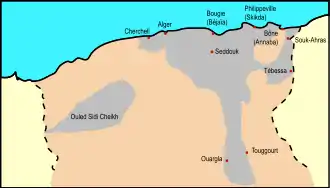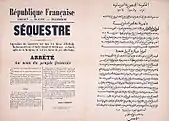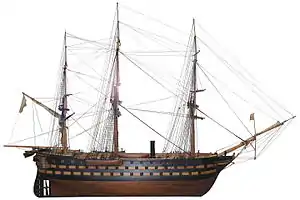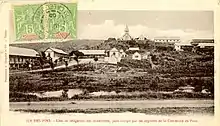Mokrani Revolt
The Mokrani Revolt, known locally as the Unfaq urrumi, ("the French war"),[4] which broke out on 16 March 1871, was the most important local uprising against French colonial power in Algeria since the conquest in 1830 : more than 250 tribes rose up, around a third of the population of the country. It was led by the Kabyles of the Biban mountains commanded by Cheikh Mokrani and his brother Boumezrag Mokrani, as well as Cheikh El Haddad, head of the Rahmaniyya religious fraternity.
| Mokrani Revolt | |||||||
|---|---|---|---|---|---|---|---|
| Part of French conquest of Algeria | |||||||
 Tribes under the Mokrani revolt | |||||||
| |||||||
| Belligerents | |||||||
|
Algerian rebels: Algerian peasants |
France: | ||||||
| Commanders and leaders | |||||||
|
|
| ||||||
| Units involved | |||||||
| 100,000 Kabyle cavalry, and 100,000 other fighters[1] | Army of Africa (86,000 men) plus native auxiliaries | ||||||
| Casualties and losses | |||||||
| ≈ 2000 dead[2] | 2,686 dead[3] | ||||||
Background

Cheikh Mokrani (Mohamed Amokrane) and his brother Boumezrag were sons of a family of high rank - the Ait Abbas dynasty (a branch of the Hafsids of Béjaïa), the Amokrane, masters, since the sixteenth century of the Kalâa of Ait Abbas in the Bibans and of the Medjana region.[5] In the 1830s, their father Ahmed El Mokrani (d. 1853), had chosen to ally himself with the French; it was he who had allowed the Iron Gates expedition in 1839 and he had become khalifa of the Medjana under the tutelage of the French authorities.[6] This alliance had soon revealed itself to be subordination - a decree of 1845 abolished the khalifalik of Medjana so that when Mohamed succeeded his father, as the choice of the Bureaux arabes, his title was no more than “Bachagha” (Turkish: başağa=chief commander).[7]:35 During the hardships of 1867, he gave his personal guarantee, at the request of the authorities, for important loans. In 1870, the creditors demanded to be repaid and the French authorities reneged on the loan on the pretext of the Franco-Prussian War, leaving Mohamed obliged to pawn his own possessions. The late 1860s were hard for the people of Algeria: between 1866 and 1868 they lived through drought, exceptionally cold winters, an epidemic of cholera and an earthquake. More than 10% of the kabyle population died during this period.[1] On 12 June 1869, Marshall MacMahon, the Governor General, advised the French government that “the Kabyles will stay peaceful as long as they see no possibility of driving us out of their country.”[8]
Under the French Second Republic, the country was governed by a Governor General and a large proportion was "military territory".[9][10] There were tensions between the French colonists and the army; the former favouring the abolition of the military territory as being too protective of the native Algerians.[11] Eventually, on 9 March 1870, the Corps législatif passed a law which would end the military regime in Algeria.[12] When Napoleon III fell and the Third French Republic was proclaimed, the Algerian question fell under the remit of the new Justice Minister, Adolphe Crémieux, and not, as previously, under the Minister of War. At the same time, Algeria was experiencing a period of anarchy. The settlers, hostile to Napoleon III and strongly Republican, took advantage of the fall of the Second Empire to push forward their anti-military agenda. Real authority devolved to town councils and local defence committees, and their pressure resulted in the Crémieux Decrees.
Start of the revolt
A number of causes have been suggested for the Mokrani revolt. There was a general dissatisfaction among Kabyle notables because of the steady erosion of their authority by the colonial authorities. At the same time, ordinary people were concerned about the imposition of civilian rule on 9 March, which they interpreted as imposing domination by the settlers, with encroachments on their land and loss of autonomy.[13] The Cremieux Decree of 24 October 1870, which gave French nationality to Algerian Jews was possibly another cause of the unrest.[7]:119[14] However some historians view this as doubtful, pointing out that this story only started to spread after the revolt was over.[15] Indeed, this explanation of the revolt was particularly widespread among French antisemites.[16] News of the insurrectionary Paris commune also played a part.[17]
Several months before the start of the insurrections, Kabyle village communities began electing village assemblies ("tijmaa'in") despite the colonial authorities having banned them from doing so. The first signs of actual revolt appeared in the mutiny of a squadron of the 3rd Regiment of Spahis in January 1871. The spahis (Muslim cavalry troopers in the French Army of Africa) refused to be sent to fight in metropolitan France,[18] claiming that they were only required to serve in Algeria. This mutiny began in Moudjebeur, near Ksar Boukhari on 20 January, spread to Aïn Guettar (in the region of modern Khemissa, near Souk Ahras) on 23 January, and soon reached El Tarf and Bouhadjar.[19]
The mutiny at Aïn Guettar involved the mass desertion of several hundred men and the killing of several officers. It took on a particular significance for the Rezgui family, whose members maintained that France, recently defeated by the Prussians, was a spent force and that now was the time for a general uprising. The Hanenchas responded to this call, killing fourteen colonists in their territory; Souk Ahras was besieged from 26 to 28 January, before being relieved by a French column, who then put down the insurgency and condemned five men to death.[19]
Mokrani submitted his resignation as bachagha in March 1871, but the army replied that only the civil government could now accept it. In reply, Mokrani wrote to General Augeraud, subdivisional commander at Sétif:[20]
"You know the matter which puts me at odds with you; I can only repeat to you what you already know - I do not wish to be the agent of the civil government..... I am preparing myself to fight you; today let each of us take up his rifle."[14]
The revolt spreads

The spahi mutiny was reignited after 16 March 1871, when Mokrani took charge of it.[14] On 16 March, Mokrani led six thousand men in an assault on Bordj Bou Arreridj.[21] On 8 April, French troops regained control of the Medjana plain. The same day, Si Aziz, son of Cheikh Ahaddad, head of the Rahmaniyya order, proclaimed a holy war in the market of Seddouk.[14] Soon 150,000 Kabyles rose,[22] as the revolt spread along the coast first, then into the mountains to the east of the Mitidja and as far as Constantine. It then spread to the Belezma mountains and linked with local insurrections all the way down to the Sahara desert.[23] As they spread towards Algiers itself, the insurgents took Lakhdaria (Palestro), 60 km east of the capital, on 14 April. By April, 250 tribes had risen, or nearly a third of Algeria's population. One hundred thousand “mujahidin”, poorly armed and disorganised, were launching random raids and attacks.[13]
French counterattack
The military authorities brought in reinforcements for the Army of Africa; Admiral de Gueydon, who took over as Governor General on 29 March, replacing Special Commissioner Alexis Lambert, mobilised 22,000 soldiers.[1] Advancing from Palestro towards Algiers, the rebels were stopped at Boudouaou (Alma) on 22 April 1871 by colonel Alexandre Fourchault under the command of General Orphis Léon Lallemand; on 5 May,[1] Mohamed El Mokrani died fighting at Oued Soufflat, halfway between Lakhdaria (Palestro) and Bouira in an encounter with the troops of General Félix Gustave Saussier.[21]
On 25 April, the Governor General declared a state of siege.[24] Twenty columns of French troops marched on Dellys and Draâ El Mizan. Cheikh Haddad and his sons were captured on 13 July after the battle of Icheriden.[25] The revolt only faded after the capture of Boumezrag, Cheikh Mokrani’s brother, on 20 January 1872.[26]
Repression

During the fighting, around 100 European civilians died, along with an unknown number of Algerian civilians.[1] After fighting ceased, more than 200 Kabyles were interned[27] and others deported to Cayenne[27] and New Caledonia, where they were known as Algerians of the Pacific.[28] Boumezrag Mokrani was condemned to death by a court in Constantine on 27 March 1873.
The Kabylie region was subjected to a collective fine of 36 million francs, and 450,000 hectares of land were confiscated and given to new settlers, many of whom were refugees from Alsace-Lorraine.[27][1] especially in the region of Constantine. The repression and confiscations forced a number of Kabyles to leave the country.[1]
Chronology of battles
| N° | Battle | Actual town | From | To | Leaders | Zawiyas |
|---|---|---|---|---|---|---|
| 01 | Battle of Bordj Bou Arréridj | Bordj Bou Arréridj | March 16, 1871 | June 2, 1871 |
|
|
| 02 | Battle of Palestro | Lakhdaria | April 14, 1871 | May 25, 1871 |
|
|
| 03 | Battle of Laazib Zamoum | Naciria | April 17, 1871 | May 22, 1871 |
|
|
| 04 | Battle of Bordj Menaïel | Bordj Menaïel | April 18, 1871 | May 18, 1871 |
|
|
| 05 | Battle of the Issers | Issers | April 18, 1871 | May 13, 1871 |
|
|
| 06 | Battle of the Col des Beni Aïcha | Thenia | April 19, 1871 | May 8, 1871 |
|
|
| 07 | Battle of Alma | Boudouaou | April 19, 1871 | April 23, 1871 |
|
|
Judicial trial of rebel leaders
After the end of the hostilities of the insurrection of Cheikh Mokrani, the Algerian rebel leaders who were captured alive appeared before the Assize Court of Algiers from 27 December 1872 on a count of indictment and an act of accusation linked to the sacking of the French colonies, the assassinations, fires and looting which sparked heated debates on this extremely important affair.[29]
Several criminal charges weighed on each of the accused who all, without exception, had taken part in the insurrection. The prosecution of the court made charges which weighed on each of the accused for the crimes alleged against these main leaders and leaders of the 1871 insurrection.
The list of these incarcerated rebel leaders is as follows:
- Cheikh Boumerdassi (1818-1874) alias "Mohamed ben Hamou ben Abdelkrim".
- Abdelkader Boumerdassi (born 1837) alias "Abdelkader ben Hamou ben Abdelkrim".
- Omar ben Zamoum[30]
- Mohamed Saïd Oulid ou Kassi (Oukaci)
- Hadj Ahmed ben Dahman
- Si Saïd ben Ali
- Si Saïd ben Ramdan
- Mohamed ben M'Ra (Merah)
- Hadj Mohamed ben Moussa
- Mohamed Amzian Oulid Yahia
- Mohamed ben Bouzid
- Moussa ben Ahmed ben Mohamed
- Saïd ben Ahmed ben Mohamed
- Ali ben Haoussin
- Amar bel Abbas
- Ahmed ben Zoubir
- Ahmed Khoia ben Mohamed
- Mohamed ben Aissa
- Mohamed ben Belkassem
- Ahmed ben Sliman
- Mohamed bel Aid
- Mohamed ben Yahia
- Ali N'Amara ou el Hadj Saïd
- Si Saïd ben Mohamed
- Omar ben Haminided
- Ahmed Oulid el hadj Ali
- Belgassem ben Gassem
- Mohamed ben Lounés
- Ali ben Amran
- Ahmed ben Amar
- Hassein el Achebeb
- Smaîn ben Omar
- Si Mohamed ou El Hadj ou Alali
- Mohamed bou Bahia
A long list was then enumerated of the names of other subordinate rebel Algerian leaders and natives who participated in the Alma and Palestro massacres.
After reading the indictment, including the whole so-called Palestro affair, which lasted about an hour and a half, the president of the assize court urged the jurors to follow on the notebook that was given to them. given to each, and where the name of each accused was written at the top of a page, the individual examination which will be carried out and to take notes due to the length of the debates.
Deportation to New Caledonia

.jpg.webp)

The leaders of the Mokrani Revolt after their capture and trial in 1873 were either executed, or subjected to forced labor, or deported and exiled to the Pacific and New Caledonia.[31][32]
It is a convoy of forty (40) Kabyle insurrectional leaders which was undertaken on the ship La Loire on 5 June 1874 towards the L'Île-des-Pins for forever deported these symbols of Algerian resistance against the French occupation.[33]
The specialist in history Malika Ouennoughi drew up a list of these 40 deportees, whose names follow:[34]
- Cheikh Boumerdassi, born in 1818 at Ouled Boumerdès, was a marabout, with the matricule: 1301.
- Ahmed ben Ali Seghir ben Mohamed Ouallal, born in 1854 at Baghlia, was a farmer, with the matricule: 852.
- Ahmed Kerbouchene, born in 1829 at Larbaâ Nath Irathen, was a farmer, with the matricule: 883.
- Ahmed ben Mohamed ben Barah, born in 1829 at Dar El Beïda, was a farmer, with the matricule: 859.
- Ahmed ben Belkacem ben Abdallah, born in 1822 at Oued Djer, was an indigene, with the matricule: 1306.
- Ahmed ben Ahmed Bokrari, born in 1838 at Bou Saâda, was an farmer, with the matricule: 857.
- Abdallah ben Ali ben Djebel, born in 1844 at Guelma, was a spahi, with the matricule: 803.
- Ahmed ben Salah ben Amar ben Belkacem, born in 1809 at Souk Ahras, was an caïd, with the matricule: 854.
On 18 May 1874, the leaders of the Mokrani Revolt were embarked at the Port of Brest in the 9th convoy of deportees from the ship La Loire placed under the orders of captain Adolphe Lucien Mottez (1822-1892).[35]
They numbered 50 Algerian deportees, and were reinforced with 280 other French convicts from the jails of Fort Quélern, and at their head the marabout Cheikh Boumerdassi.[36]
This ship arrived on 7 June at the anchorage of the port of Île-d'Aix, where it embarked 700 passengers, including 40 women, and 320 other French deportees.[37]
On 9 June, he left for Nouméa, and it was therefore the 9th convoy of deportees that left France to then stop on 23 June in Santa Cruz de Tenerife, to arrive in Nouméa on 16 October 1874.
It is thus after a last stopover in Santa Catarina, that La Loire arrives in Nouméa on 16 October 1874 after a journey of 133 days.[38]
There will be around 5 deaths at sea and on 10 November of the same year, the ship "La Loire" left Noumea to return to France after having disembarked the convicts from Kabylia.[39]
Of the 40 or 50 Algerians mentioned, 39 were destined for simple deportation to the L'Île-des-Pins, and only one of them for deportation to a fortified enclosure.
Of the 300 convoys in the convoy, 250 suffered from scurvy, and will die in the weeks following their arrival in New Caledonia according to Roger Pérennès.[40][41]
In Mémoires d'un Communard, Jean Allemane evokes a deadly epidemic of dysentery which decimated the transported people that La Loire had just landed, and who were buried in large numbers.[42][43]
Begun at dawn, the burial of the corpses was a task which often did not end until nightfall, and the men who had died of dysentery presented a morbid spectacle.[44][45]
More than two hundred convicts who had come by the Loire died almost immediately after their disembarkation.[46]
However Louis-José Barbançon reports that on the civil status registers of the Bagne of L'Île-des-Pins, which were very well kept, only 28 deaths of convicts who came by "La Loire" appear in the 6 months after arrival of the ship.[47][48]
See also
- Zawiyas in Algeria
- Rahmaniyya
- Zawiyet Sidi Boumerdassi
- Cheikh Boumerdassi
- Fort Quélern
- French ship Prince Jérôme
Bibliography
- Mottez, Adolphe Lucien (1875). Deux Expériences faites à bord de la Loire pendant un voyage en Nouvelle-Calédonie. 1874-1875. p. 83.
References
- Zancarini-Fournel, Michelle (2016). "Les communes, le peuple au pouvoir?". In Éditions La Découverte (ed.). Les luttes et les rêves (in French). Paris. p. 375. ISBN 9782355220883.
- Catalogue de l'exposition L'Algérie à l'ombre des armes, 1830 – 1962. Casterman BD. 26 March 2010. pp. 90–. ISBN 978-2-203-06168-2.
- Yacono, X (April 2004). "Kabylie: L'insurrection de 1871". Encyclopédie Berbère: 4022–4026. Retrieved 30 April 2018.
- Allioui, Youcef (2008). La sagesse des oiseaux. L’Harmattan. p. 32. ISBN 978-2296049611.
- Féraud, Laurent-Charles (2011). Histoire Des Villes de la Province de Constantine: Sétif, Bordj-Bou-Arreridj, Msila, Boussaâda. 5 vol. 5. Arnolet. pp. 208–211. ISBN 978-2-296-54115-3.
- Gaïd, Mouloud (1978). Chroniques des Beys de Constantine. Algiers: Office des publications universitaires. p. 114.
- Rinn, Louis (1891). Histoire de l'Insurrection de 1871 en Algerie (PDF). Algiers: Librairie Adolphe Jourdan.
- Ageron, Charles-Robert (1966). "La politique kabyle sous le Second Empire" [Kabyle politics under the Second Empire]. Outre-Mers. Revue d'histoire (in French). 53 (190): 102. Retrieved 30 April 2018.
- Murray Steele, 'Algeria: Government and Administration, 1830-1914', Encyclopedia of African History, ed. by Kevin Shillington, 3 vols (New York: Fitzroy Dearborn, 2005), I pp. 50-52 (at p. 51).
- Lorcy, Damien (2011). "Sous le régime du sabre" (PDF). Presses universitaires de Rennes. Retrieved 30 April 2018. p.17
- Le Régime du Sabre en Algerie. Paris: Dentu. 1869. p. 20.
- Rey-Goldzeiguer, Annie (1981). "Le Royaume Arabe. La politique algérienne de Napoléon III, I861-1870" [The Arab Kingdom: the Algerian policy of Napoleon III 1861-1870]. Revue d'Histoire Moderne & Contemporaine (in French). 28 (2): 383. Retrieved 30 April 2018.
- Bernard Droz, « Insurrection de 1871: la révolte de Mokrani », dans Jeannine Verdès-Leroux (dir.), L'Algérie et la France, Paris, Robert Laffont 2009, p. 474-475 ISBN 978-2-221-10946-5
- Liorel, Jules (1892). E. Leroux (ed.). Races berbères: Kabylie du Djurdjura. Paris. pp. 247–249.
- Ayoun, Richard (1988). Presses universitaires de France (ed.). "Le décret Crémieux et l'insurrection de 1871 en Algérie". Revue d'histoire moderne et contemporaine, tome XXXV. Paris. 35 (1): 61–87. doi:10.3406/rhmc.1988.1439.
- Ait Kaki, Maxine (2004). Éditions L'Harmattan (ed.). De la question berbère au dilemme kabyle à l'aube du sXXI. ISBN 9782747557283.
- Bertolini, Gilbert (13 April 2012). "La Commune de Paris et l'Algérie". www.commune1871.org. Commune 1871. Retrieved 30 April 2018.
- R. Hure, page 155, L'Armee d'Afrique 1830–1962, Charles-Lavauzelle 1977
- Julien, Charles-André (1964). Histoire de l'Algérie contemporaine. 1. Paris: PUF. pp. 475–476.
- Lettre de Mokrani au Général Augerand, dans le Rapport de M. Léon de La Sicotière au nom de la « Commission d’Enquête sur les actes du Gouvernement de la Défense Nationale », Versailles, Cerf et fils, 1875, p. 768
- Jolly, Jean (1996). Histoire du continent africain: de la préhistoire à 1600. 1. Éditions L'Harmattan. ISBN 9782738446886.
- Naylor, Phillip (2006). Historical Dictionary of Algeria. Scarecrow Press. p. 305. ISBN 9780810864801.
- Wahl, Maurice (1896). La France aux colonies. Paris: Librairies-Imprimeries réunies.
- Bulletin officiel du gouvernement général de l'Algérie. 11. Algiers: Bouyer. 1872. p. 188.
- Darmon, Pierre (2009). Un siècle de passions algériennes: Histoire de l'Algérie coloniale (1830-1940). Fayard. p. 271. ISBN 9782213653990.
- Montagnon, Pierre (2012-12-15). La conquête de l'Algérie : Les germes de la discorde. Éditions Flammarion. p. 471. ISBN 9782756408774.
- Moussaoui, Rosa (5 September 2011). "Cheikh El Mokrani (1815-1871) Le chef de la Commune kabyle, en guerre contre la colonisation (43)". www.humanite.fr. L’Humanité. Retrieved 30 April 2018.
- Léon Devambez. "Camp des déportés arabes à la presqu'ile Ducos". Archives nationales d'outremer. Archived from the original on 26 August 2014. Retrieved 13 July 2012.
- https://gallica.bnf.fr/ark:/12148/bpt6k75566762/f3.item.r=Palestro+Aicha+Alma.zoom
- https://gallica.bnf.fr/ark:/12148/bpt6k63482733/f188.item.r=Omar+Zamoum.zoom
- http://etudescoloniales.canalblog.com/archives/2006/10/12/2896840.html
- http://www.iisg.nl/collections/new-caledonia/names-fr.php
- http://www.iisg.nl/collections/new-caledonia/nettlau-3155.pdf
- http://etudescoloniales.canalblog.com/archives/2011/05/14/21135512.html
- https://www.bernard-guinard.com/arcticles%20divers/Convois%20de%20deportes/Loire/la_Loire.html
- https://books.google.dz/books?id=LSOsRPJA1j8C&pg=PA83#v=onepage&q&f=false
- https://books.google.dz/books?id=dEp0AAAAMAAJ
- https://books.google.dz/books?id=p6lyAAAAMAAJ
- https://books.google.dz/books?id=PTeVFpRTZ5kC
- https://gallica.bnf.fr/ark:/12148/bpt6k3337001q/f7.zoom
- https://books.google.dz/books?id=ypoEAQAAIAAJ
- https://gallica.bnf.fr/ark:/12148/bpt6k10732741/f9.item.zoom
- https://books.google.dz/books?id=PWMJPwAACAAJ
- https://books.google.dz/books?id=V208AAAAMAAJ
- https://www.persee.fr/doc/jso_0300-953x_1971_num_27_31_2322
- https://books.google.dz/books?id=L3HZoAEACAAJ
- https://books.google.dz/books?id=LnCHD3XJszoC
- https://books.google.dz/books?id=6zEGEAAAQBAJ
.png.webp)